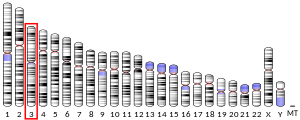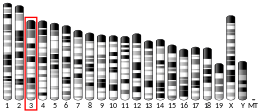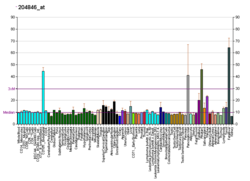Ceruloplasmin(orcaeruloplasmin) is aferroxidaseenzymethat in humans is encoded by theCPgene.[5][6][7]
| CP | |||||||||||||||||||||||||||||||||||||||||||||||||||
|---|---|---|---|---|---|---|---|---|---|---|---|---|---|---|---|---|---|---|---|---|---|---|---|---|---|---|---|---|---|---|---|---|---|---|---|---|---|---|---|---|---|---|---|---|---|---|---|---|---|---|---|
 | |||||||||||||||||||||||||||||||||||||||||||||||||||
| |||||||||||||||||||||||||||||||||||||||||||||||||||
| Identifiers | |||||||||||||||||||||||||||||||||||||||||||||||||||
| Aliases | CP,CP-2, ceruloplasmin (ferroxidase), Ceruloplasmin, AB073614 | ||||||||||||||||||||||||||||||||||||||||||||||||||
| External IDs | OMIM:117700;MGI:88476;HomoloGene:75;GeneCards:CP;OMA:CP - orthologs | ||||||||||||||||||||||||||||||||||||||||||||||||||
| EC number | 1.16.3.1 | ||||||||||||||||||||||||||||||||||||||||||||||||||
| |||||||||||||||||||||||||||||||||||||||||||||||||||
| |||||||||||||||||||||||||||||||||||||||||||||||||||
| |||||||||||||||||||||||||||||||||||||||||||||||||||
| |||||||||||||||||||||||||||||||||||||||||||||||||||
| |||||||||||||||||||||||||||||||||||||||||||||||||||
| Wikidata | |||||||||||||||||||||||||||||||||||||||||||||||||||
| |||||||||||||||||||||||||||||||||||||||||||||||||||
Ceruloplasmin is the majorcopper-carrying protein in the blood, and in addition plays a role iniron metabolism.It was first described in 1948.[8]Another protein,hephaestin,is noted for its homology to ceruloplasmin, and also participates in iron and probably copper metabolism.
Function
editCeruloplasmin (CP) is anenzyme(EC1.16.3.1) synthesized in the liver containing 6 atoms ofcopperin its structure.[9]Ceruloplasmin carries more than 95% of the total copper in healthy human plasma.[10]The rest is accounted for by macroglobulins. Ceruloplasmin exhibits a copper-dependent oxidase activity, which is associated with possible oxidation of Fe2+(ferrous iron) into Fe3+(ferric iron), therefore assisting in its transport in the plasma in association withtransferrin,which can carry iron only in the ferric state.[11]The molecular weight of human ceruloplasmin is reported to be 151kDa.
Despite extensive research, much is still unknown about the exact functions of CP, most of the functions are attributed to CP focus on the presence of the Cu centers. These include copper transport to deliver the Cu to extrahepatic tissues, amine oxidase activity that controls the level of biogenic amines in intestinal fluids and plasma, removal of oxygen and other free radicals from plasma, and theexport of ironfrom cells for transport throughtransferrin.[12]
Mutations have been known to disrupt the binding of copper to CP and will disrupt iron metabolism and cause aniron overload.
Ceruloplasmin is a relatively large enzyme (~10 nm); the larger size prevents the bound copper from being lost in aperson's urineduring transport.
Active site structure
editThe multicopper active site of CP contains atype I(T1) mononuclear copper[12]site and a trinuclear copper center ~ 12-13 Å away (see figure 2). The tricopper center consists of twotype III(T3) coppers and onetype II(T2) copper ion. The two T3 copper ions are bridged by a hydroxide ligand while another hydroxide ligand links the T2 copper ion to the protein. The T1 center is bridged to the tricopper center by twohistidine(His1020, His1022) residues and oneCys(1021) residue. The substrate binds near the T1 center and is oxidized by the T1 Cu2+ion forming the reduced Cu+oxidation state. The reduced T1 Cu+then transfers the electron through the one Cys and two His bridging residues to the tricopper center. After four electrons have been transferred from the substrates to the copper centers, an O2binds at the tricopper center and undergoes a four-electron reduction to form two molecules of water.[12]
Regulation
editAcis-regulatory elementcalled theGAIT elementis involved in the selective translational silencing of the Ceruloplasmin transcript.[13] The silencing requires binding of a cytosolic inhibitor complex called IFN-gamma-activated inhibitor of translation (GAIT) to the GAIT element.[14]
Clinical significance
editLike any other plasma protein, levels drop in patients with hepatic disease due to reduced synthesizing capabilities.
Mechanisms of low ceruloplasmin levels:
- Gene expression genetically low (aceruloplasminemia)
- Copper levels are low in general
- Malnutrition/trace metal deficiency in the food source
- Zinc toxicity,due to induced copper deficiency
- Copper does not cross the intestinal barrier due toATP7Adeficiency (Menkes diseaseandOccipital horn syndrome)
- Delivery of copper into the lumen of theER-Golginetwork is absent inhepatocytesdue to absentATP7B(Wilson's disease)
Copper availability doesn't affect the translation of the nascent protein. However, the apoenzyme without copper is unstable. Apoceruloplasmin is largely degraded intracellularly in thehepatocyteand the small amount that is released has a short circulation half life of 5 hours as compared to the 5.5 days for the holo-ceruloplasmin.
Ceruloplasmin can be measured by means of a blood test;[15]this can be done usingimmunoassays.The sample is spun and separated; it is stored around 4 °C Celsius for three days. This test is to determine if there are signs of Wilson disease. Another test that can be done is a urine copper level test; this has been found to be less accurate than the blood test. A liver tissue test can be done as well.
Mutations in the ceruloplasmin gene (CP), which are very rare, can lead to the genetic diseaseaceruloplasminemia,characterized by hyperferritinemia withiron overload.In the brain, this iron overload may lead to characteristic neurologic signs and symptoms, such as cerebellarataxia,progressivedementia,andextrapyramidal signs.Excess iron may also deposit in the liver, pancreas, and retina, leading tocirrhosis,endocrineabnormalities, and loss of vision, respectively.
Deficiency
editLower-than-normal ceruloplasmin levels may indicate the following:
- Wilson disease(a rare [UK incidence 2/100,000] copper storage disease).[16]
- Menkes disease(Menkes kinky hair syndrome) (rare – UK incidence 1/100,000)
- Copperdeficiency
- Aceruloplasminemia[17]
- Zinc toxicity
Excess
editGreater-than-normal ceruloplasmin levels may indicate or be noticed in:
- copper toxicity/zinc deficiency
- pregnancy
- oral contraceptive pilluse[18]
- lymphoma
- acute and chronicinflammation(it is anacute-phase reactant)
- rheumatoid arthritis
- Angina[19]
- Alzheimer's disease[20]
- Schizophrenia[21]
- Obsessive-compulsive disorder[22]
Reference ranges
editNormal blood concentration of ceruloplasmin in humans is 20–50 mg/dL.
References
edit- ^abcGRCh38: Ensembl release 89: ENSG00000047457–Ensembl,May 2017
- ^abcGRCm38: Ensembl release 89: ENSMUSG00000003617–Ensembl,May 2017
- ^"Human PubMed Reference:".National Center for Biotechnology Information, U.S. National Library of Medicine.
- ^"Mouse PubMed Reference:".National Center for Biotechnology Information, U.S. National Library of Medicine.
- ^Takahashi N, Ortel TL, Putnam FW (Jan 1984)."Single-chain structure of human ceruloplasmin: the complete amino acid sequence of the whole molecule".Proceedings of the National Academy of Sciences of the United States of America.81(2):390–4.Bibcode:1984PNAS...81..390T.doi:10.1073/pnas.81.2.390.PMC344682.PMID6582496.
- ^Koschinsky ML,Funk WD, van Oost BA, MacGillivray RT (Jul 1986)."Complete cDNA sequence of human preceruloplasmin".Proceedings of the National Academy of Sciences of the United States of America.83(14):5086–90.Bibcode:1986PNAS...83.5086K.doi:10.1073/pnas.83.14.5086.PMC323895.PMID2873574.
- ^Royle NJ, Irwin DM, Koschinsky ML, MacGillivray RT, Hamerton JL (May 1987). "Human genes encoding prothrombin and ceruloplasmin map to 11p11-q12 and 3q21-24, respectively".Somatic Cell and Molecular Genetics.13(3):285–92.doi:10.1007/BF01535211.PMID3474786.S2CID45686258.
- ^Holmberg CG, Laurell CB (1948)."Investigations in serum copper. II. Isolation of the Copper containing protein, and a description of its properties".Acta Chem Scand.2:550–56.doi:10.3891/acta.chem.scand.02-0550.
- ^O'Brien PJ, Bruce WR (2009).Endogenous Toxins: Targets for Disease Treatment and Prevention, 2 Volume Set.John Wiley & Sons. pp.405–6.ISBN978-3-527-32363-0.
- ^Hellman NE, Gitlin JD (2002). "Ceruloplasmin metabolism and function".Annual Review of Nutrition.22:439–58.doi:10.1146/annurev.nutr.22.012502.114457.PMID12055353.
- ^Song D, Dunaief JL (2013)."Retinal iron homeostasis in health and disease".Frontiers in Aging Neuroscience.5:24.doi:10.3389/fnagi.2013.00024.PMC3695389.PMID23825457.
- ^abcBertini I (2007).Biological Inorganic Chemistry.California, USA: University Science Books. pp.426–442.ISBN978-1-891389-43-6.
- ^Sampath P, Mazumder B, Seshadri V, Fox PL (Mar 2003)."Transcript-selective translational silencing by gamma interferon is directed by a novel structural element in the ceruloplasmin mRNA 3' untranslated region".Molecular and Cellular Biology.23(5):1509–19.doi:10.1128/MCB.23.5.1509-1519.2003.PMC151701.PMID12588972.
- ^Mazumder B, Sampath P, Fox PL (Oct 2005)."Regulation of macrophage ceruloplasmin gene expression: one paradigm of 3'-UTR-mediated translational control".Molecules and Cells.20(2):167–72.doi:10.1016/S1016-8478(23)13213-4.PMID16267389.
- ^"Ceruloplasmin Test: MedlinePlus Medical Test".medlineplus.gov.Retrieved2021-12-10.
- ^Scheinberg IH, Gitlin D (Oct 1952). "Deficiency of ceruloplasmin in patients with hepatolenticular degeneration (Wilson's disease)".Science.116(3018):484–5.Bibcode:1952Sci...116..484S.doi:10.1126/science.116.3018.484.PMID12994898.
- ^Gitlin JD (Sep 1998)."Aceruloplasminemia".Pediatric Research.44(3):271–6.doi:10.1203/00006450-199809000-00001.PMID9727700.
- ^Elkassabany NM, Meny GM, Doria RR, Marcucci C (Apr 2008)."Green plasma-revisited".Anesthesiology.108(4):764–5.doi:10.1097/ALN.0b013e3181672668.PMID18362615.
- ^Ziakas A, Gavrilidis S, Souliou E, Giannoglou G, Stiliadis I, Karvounis H, Efthimiadis G, Mochlas S, Vayona MA, Hatzitolios A, Savopoulos C, Pidonia I, Parharidis G (2009). "Ceruloplasmin is a better predictor of the long-term prognosis compared with fibrinogen, CRP, and IL-6 in patients with severe unstable angina".Angiology.60(1):50–9.doi:10.1177/0003319708314249.PMID18388036.S2CID843454.
- ^Lutsenko S, Gupta A, Burkhead JL, Zuzel V (Aug 2008)."Cellular multitasking: the dual role of human Cu-ATPases in cofactor delivery and intracellular copper balance".Archives of Biochemistry and Biophysics.476(1):22–32.doi:10.1016/j.abb.2008.05.005.PMC2556376.PMID18534184.
- ^Wolf TL, Kotun J, Meador-Woodruff JH (Sep 2006). "Plasma copper, iron, ceruloplasmin and ferroxidase activity in schizophrenia".Schizophrenia Research.86(1–3):167–71.doi:10.1016/j.schres.2006.05.027.PMID16842975.S2CID38267889.
- ^Virit O, Selek S, Bulut M, Savas HA, Celik H, Erel O, Herken H (2008)."High ceruloplasmin levels are associated with obsessive compulsive disorder: a case control study".Behavioral and Brain Functions.4:52.doi:10.1186/1744-9081-4-52.PMC2596773.PMID19017404.
Further reading
edit- Hellman NE, Gitlin JD (2002). "Ceruloplasmin metabolism and function".Annual Review of Nutrition.22:439–58.doi:10.1146/annurev.nutr.22.012502.114457.PMID12055353.
- Mazumder B, Seshadri V, Fox PL (Feb 2003). "Translational control by the 3'-UTR: the ends specify the means".Trends in Biochemical Sciences.28(2):91–8.doi:10.1016/S0968-0004(03)00002-1.PMID12575997.
- Giurgea N, Constantinescu MI, Stanciu R, Suciu S, Muresan A (Feb 2005). "Ceruloplasmin - acute-phase reactant or endogenous antioxidant? The case of cardiovascular disease".Medical Science Monitor.11(2): RA48-51.PMID15668644.
- Kingston IB, Kingston BL, Putnam FW (Dec 1977)."Chemical evidence that proteolytic cleavage causes the heterogeneity present in human ceruloplasmin preparations".Proceedings of the National Academy of Sciences of the United States of America.74(12):5377–81.Bibcode:1977PNAS...74.5377K.doi:10.1073/pnas.74.12.5377.PMC431726.PMID146197.
- Polosatov MV, Klimov PK, Masevich CG, Samartsev MA, Wünsch E (Apr 1979). "Interaction of synthetic human big gastrin with blood proteins of man and animals".Acta Hepato-Gastroenterologica.26(2):154–9.PMID463490.
- Schilsky ML, Stockert RJ, Pollard JW (Dec 1992)."Caeruloplasmin biosynthesis by the human uterus".The Biochemical Journal.288(2):657–61.doi:10.1042/bj2880657.PMC1132061.PMID1463466.
- Walker FJ, Fay PJ (Feb 1990)."Characterization of an interaction between protein C and ceruloplasmin".The Journal of Biological Chemistry.265(4):1834–6.doi:10.1016/S0021-9258(19)39903-X.PMID2105310.
- Fleming RE, Gitlin JD (May 1990)."Primary structure of rat ceruloplasmin and analysis of tissue-specific gene expression during development".The Journal of Biological Chemistry.265(13):7701–7.doi:10.1016/S0021-9258(19)39171-9.PMID2332446.
- Yang FM, Friedrichs WE, Cupples RL, Bonifacio MJ, Sanford JA, Horton WA, Bowman BH (Jun 1990)."Human ceruloplasmin. Tissue-specific expression of transcripts produced by alternative splicing".The Journal of Biological Chemistry.265(18):10780–5.doi:10.1016/S0021-9258(18)87015-6.PMID2355023.
- Yang F, Naylor SL, Lum JB, Cutshaw S, McCombs JL, Naberhaus KH, McGill JR, Adrian GS, Moore CM, Barnett DR (May 1986)."Characterization, mapping, and expression of the human ceruloplasmin gene".Proceedings of the National Academy of Sciences of the United States of America.83(10):3257–61.Bibcode:1986PNAS...83.3257Y.doi:10.1073/pnas.83.10.3257.PMC323492.PMID3486416.
- Mercer JF, Grimes A (Jul 1986). "Isolation of a human ceruloplasmin cDNA clone that includes the N-terminal leader sequence".FEBS Letters.203(2):185–90.doi:10.1016/0014-5793(86)80739-6.PMID3755405.S2CID23472934.
- Rask L, Valtersson C, Anundi H, Kvist S, Eriksson U, Dallner G, Peterson PA (Jan 1983). "Subcellular localization in normal and vitamin A-deficient rat liver of vitamin A serum transport proteins, albumin, ceruloplasmin and class I major histocompatibility antigens".Experimental Cell Research.143(1):91–102.doi:10.1016/0014-4827(83)90112-X.PMID6337857.
- Kressner MS, Stockert RJ, Morell AG, Sternlieb I (1984). "Origins of biliary copper".Hepatology.4(5):867–70.doi:10.1002/hep.1840040512.PMID6479854.S2CID43824397.
- Takahashi N, Bauman RA, Ortel TL, Dwulet FE, Wang CC, Putnam FW (Jan 1983)."Internal triplication in the structure of human ceruloplasmin".Proceedings of the National Academy of Sciences of the United States of America.80(1):115–9.Bibcode:1983PNAS...80..115T.doi:10.1073/pnas.80.1.115.PMC393320.PMID6571985.
- Dwulet FE, Putnam FW (Feb 1981)."Complete amino acid sequence of a 50,000-dalton fragment of human ceruloplasmin".Proceedings of the National Academy of Sciences of the United States of America.78(2):790–4.Bibcode:1981PNAS...78..790D.doi:10.1073/pnas.78.2.790.PMC319888.PMID6940148.
- Kingston IB, Kingston BL, Putnam FW (Apr 1980)."Primary structure of a histidine-rich proteolytic fragment of human ceruloplasmin. I. Amino acid sequence of the cyanogen bromide peptides".The Journal of Biological Chemistry.255(7):2878–85.doi:10.1016/S0021-9258(19)85822-2.PMID6987229.
External links
edit- GeneReviews/NCBI/NIH/UW entry on Aceruloplasminemia
- OMIM entries on Aceruloplasminemia
- Overview of all the structural information available in thePDBforUniProt:P00450(Human Ceruloplasmin) at thePDBe-KB.




